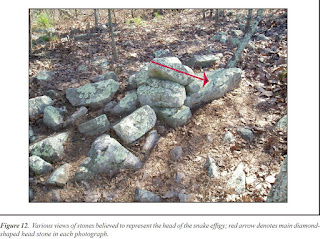I was Snoozing on Turtle Island again it
seems. Looking at the Archives of Rock Piles and then this blog, only confirms it:
in the latter there are no entries at all, but in the former I found the very astute
avocational observer and researcher Rob Buchanan had posted up a link on July 10,
2010 that led right to a report of a Snake (or Great Serpent) Effigy on
Skeleton Mountain in Alabama: http://rockpiles.blogspot.com/2010/07/more-on-serpentine-walls.html
The post generated
no comments, despite many posts with photographic images and drawings about
Snake Walls and Great Serpent Effigies on the blog over the last ten years or
so. My guess is that the link didn’t include photographs, while as for the
reason why I was snoozing is anybody’s guess - I don’t really have a clue.
Tickling Google this morning, I found an illustrated version
at:
(Although I had to tickle that a little bit too to get
something that worked well.)
Anyway, I found that way back “In March of
2007, the Jacksonville State University (JSU) Archaeological Resource
Laboratory (ARL) staff and several local volunteers began the preliminary
investigation of a serpentine-like stone feature that lies upon the crest of
Skeleton Mountain…in Calhoun County, Alabama. Researchers believe prehistoric
Woodland Indian populations constructed this structure nearly 2,500 years ago
as part of their ceremonial/mortuary rituals. The investigation involved
clearing the structure and any associated stone features of vegetation, then
mapping and photographing the structure and features. In addition, researchers
assessed, photographed, and mapped portions of the effigy that were damaged
from past earth-moving operations…
During the spring
of 2004, tribal leaders, local officials, and JSU archaeologists visited the
Snake Effigy. Native American representatives were in agreement as to the
ceremonial and spiritual sacredness of the site. It was also agreed that the Snake
Effigy needed immediate protection and that plans should be made to map and
photograph the structure in the near future.”
You even find it
mentioned that “As the first explorers and subsequent settlers of the late
1500, 1600, and 1700s moved into the lands east of the Atlantic seaboard, they
frequently encountered heaps of stones and stone walls. By the 1800 and 1900s,
hundreds of these stone structures, which frequently would have required
considerable labor to construct, were observed as far west as the Mississippi
River.” And of course that “Typically, their construction was attributed to
farmers or settlers who created stone piles and walls as they cleared their
property for various economical pursuits (to which I would add: ethnically erasing Indigenous People
from their homelands to appropriate a mythical pristine wilderness by creating that
farmer/settler myth about stone structures and especially anything that might
resemble a fence or walls – and “far wester” than the Mississippi as well too).
There is a whole
lot of information by Dr. Harry Holstein in that report and I admire his
efforts. I’d invite him over for dinner so I could show him a local CT Serpent
Effigy or three – actually a whole lot more.
Or maybe I’d invite
myself to dinner at his house, so I could see if I could take a Snake (or Great
Serpent) Tour or two, look for some patterns in them there that I see in them
here – snake scales and rhomboidals, serpents and bears, anthropomorphic faces
etc.
And eyes!
I think I’ve "got an
eye" for Serpents with eyes, and even in the photos in that report I think I
see eye on one of those Serpent Heads - and what ever you call that spot that is where a snake's ear is:





No comments:
Post a Comment